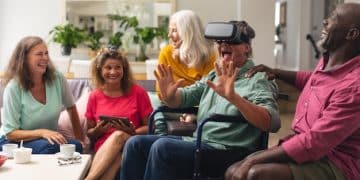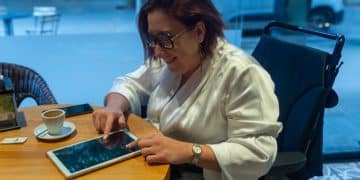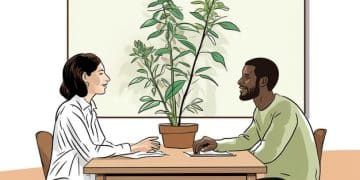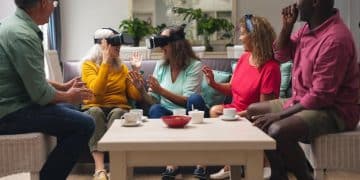Home Safety Checklist: Preventing Falls and Accidents for Loved Ones
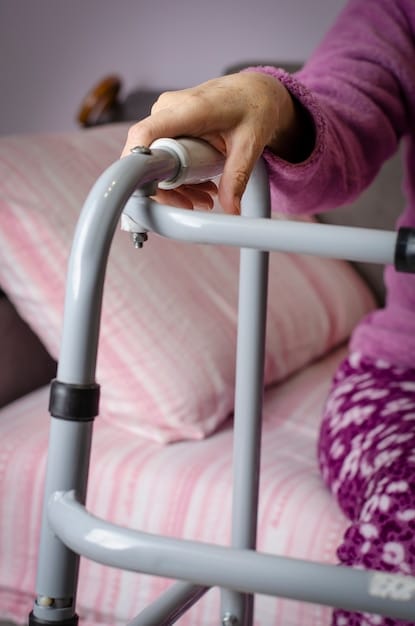
A home safety checklist focusing on fall and accident prevention is vital for ensuring the well-being of loved ones, involving hazard identification, home modification, and adaptive strategies to create a secure and comfortable environment.
Ensuring the safety and well-being of your loved ones at home is paramount, especially as they age or face mobility challenges. A comprehensive home safety checklist: preventing falls and accidents for your loved one is an essential tool for caregivers to proactively identify and mitigate potential hazards within the home environment.
Why is a Home Safety Checklist Important?
Creating a safe home environment is crucial to ensuring the health, independence, and quality of life for your loved ones. A proactive approach to safety not only minimizes the risk of falls and accidents but also fosters a sense of security and well-being for everyone in the household.
By implementing a carefully crafted home safety checklist, caregivers can systematically identify potential hazards and take appropriate measures to address them. This preventative strategy promotes a secure and comfortable living space that supports the physical, emotional, and psychological needs of those under their care. Understanding the importance of home safety is the first step in creating a secure, nurturing environment.
Preventing Falls
Falls are a leading cause of injury among older adults, contributing to fractures, head trauma, and a decline in overall well-being. Recognizing the risk factors and implementing preventative measures is essential for fostering a safer home environment.
- Assessing Fall Risks: Evaluating the physical abilities, medical conditions, and medications of your loved one to identify potential fall risks is a vital first step.
- Home Hazards: Identifying and eliminating hazards such as loose rugs, cluttered pathways, and inadequate lighting can significantly reduce the likelihood of falls.
- Adaptive Equipment: Providing assistive devices such as walkers, canes, and grab bars can improve stability and balance, enabling your loved one to move around the home with confidence and independence.
Reducing Accidents
Accidents within the home can range from minor cuts and burns to more serious injuries requiring medical attention. Caregivers can take steps to minimize these risks by addressing potential dangers and ensuring that the home environment is optimized for safety.
- Kitchen Safety: Implementing safety measures in the kitchen, such as storing sharp objects securely, using non-slip mats, and ensuring proper ventilation, can help prevent burns, cuts, and other accidents.
- Bathroom Safety: Installing grab bars in the shower and near the toilet, using a shower chair, and regulating water temperature can reduce the risk of slips, scalds, and falls in the bathroom.
- Medication Safety: Properly storing medications in a secure location, ensuring that they are taken as prescribed, and monitoring for potential side effects can help prevent adverse reactions and medication-related accidents.
By understanding and addressing these risks, caregivers can create a safer and more supportive home environment. This attention to detail ensures the well-being of their loved ones.
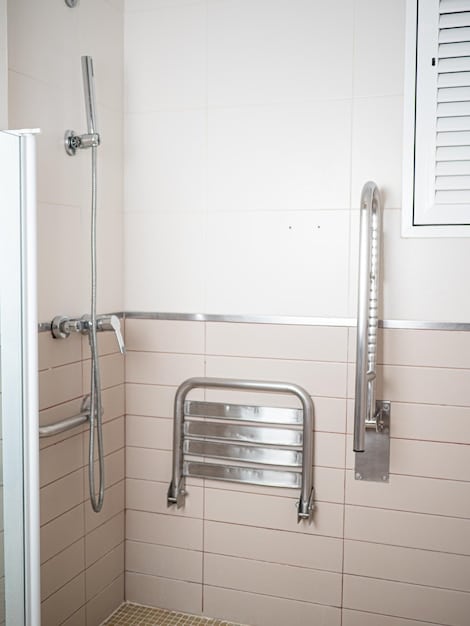
Key Areas to Inspect in Your Home
A thorough home safety assessment involves examining key areas of the home to identify potential hazards. By systematically evaluating each space, caregivers can ensure that every aspect of the environment promotes safety and minimizes risk. This proactive approach is an important part of any home safety strategy.
Starting with high-risk areas and meticulously moving room to room, you need to look for anything that could cause injury in the home. You are not just focusing on what is in the room. Ensure you spend time considering the flooring, height and light when assessing if a particular room is safe.
Living Room Safety
The living room is often a central gathering place in the home, and it’s important to ensure that it is free from hazards. Evaluating furniture placement, electrical cords, and flooring surfaces can help minimize the risk of falls and other accidents.
Clear pathways and easy access to seating promotes mobility, allowing your loved one to navigate the space confidently and independently. Consider removing clutter from the floors, secure cords to prevent tripping hazards, and improve lighting to ensure your loved one can move freely around the room.
Bedroom Safety
The bedroom should be a safe and comfortable retreat. Caregivers can enhance sleep safety by addressing lighting, bed height, and accessibility to essential items, thus preventing accidents that could easily occur with tired movements.
Adding a night light, easy access to their bed and emergency items such as a cordless phone can help prevent nocturnal falls or accidents. Make sure pathways are well-lit and free of tripping hazards such as wires or loose rugs.
Kitchen and Dining Area Safety
The kitchen and dining area present unique safety challenges due to the presence of hot surfaces, sharp objects, and potential spills. By addressing these risks, caregivers can ensure that meal preparation and dining experiences are safe and enjoyable.
The simplest solution is to keep cluttered surfaces clean, store heavy objects in easy-to-reach locations, and label the items. Making sure floors stay dry and there is sufficient lighting will also help prevent an accident.
Regular inspections and proactive measures in these key areas can dramatically reduce the chance of accidents. A safe home is a home where your aging loved ones can thrive.
Modifying Your Home for Safety
Adapting the home environment to meet the changing needs of your loved one can significantly enhance safety and promote independence. Home modifications may include structural changes, assistive devices, and adaptive equipment designed to minimize risks and support daily activities. This is a critical step in making your home safe to live in.
Depending on the requirements and needs of your family member or friend, these changes may be small and cost effective, or may involve a bigger time and money commitment.
Installing Grab Bars
Installing grab bars in key areas such as bathrooms and hallways can provide additional support and stability for individuals with mobility challenges. These devices enable your loved one to maintain balance and prevent falls while performing essential tasks.
- Bathroom Installation: Grab bars should be strategically placed in the shower and near the toilet to assist with standing, sitting, and maintaining balance.
- Hallway Installation: Installing grab bars along hallways can provide support while navigating the home, particularly for those with unsteady gait.
- Proper Placement: Consulting with a healthcare professional or occupational therapist can help determine the optimal placement and type of grab bars for your loved one’s specific needs.
Improving Lighting
Adequate lighting is essential for promoting visibility and preventing falls, especially in hallways, stairwells, and bathrooms. By increasing illumination and addressing dark spots, caregivers can create a safer and more navigable environment.
- Increased Lumens: Using brighter light bulbs can improve overall visibility and reduce the risk of tripping or stumbling.
- Night Lights: Installing night lights in bedrooms, hallways, and bathrooms can provide gentle illumination during nighttime hours, enabling your loved one to navigate the home safely.
- Motion Sensors: Installing motion-sensing lights can provide automated illumination in key areas, reducing the need for manual switches and minimizing the risk of falls.
Removing Tripping Hazards
Eliminating tripping hazards such as loose rugs, electrical cords, and clutter is essential for preventing falls, especially for older adults with limited mobility. Simplifying the layout and pathways within the home can significantly reduce the risk of accidents.
- Secure Loose Rugs: Using non-slip mats or removing loose rugs altogether can prevent slips and falls.
- Organize Electrical Cords: Securing electrical cords along walls or using cord organizers can eliminate tripping hazards and reduce the risk of accidents.
- Clear Clutter: Regularly decluttering walkways and living spaces can create clear and unobstructed paths, minimizing the risk of falls.
These modifications can dramatically improve the safety of a home, ensuring loved ones live in an environment tailored to their needs.
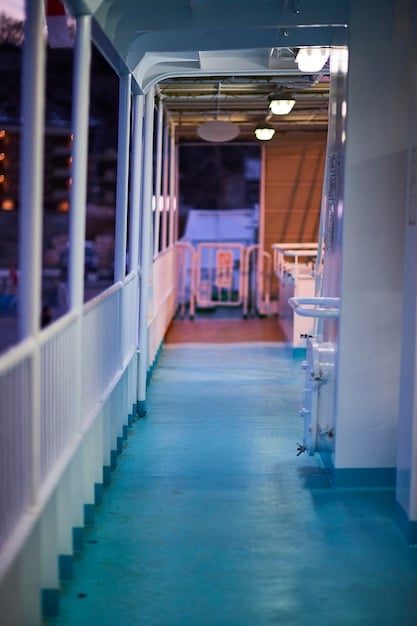
Adaptive Strategies and Equipment for Enhanced Safety
Employing adaptive strategies and equipment is crucial for enhancing the safety and independence of your loved one. These strategies aim to address specific needs based on physical abilities and medical conditions.
The following are some proven solutions that are designed to meet physical limits and medical conditions and aid caregivers who look after their loved ones. The idea is to minimize risks and support daily activities.
Using Mobility Aids
Mobility aids such as walkers, canes, and wheelchairs can provide additional support and stability for individuals with mobility challenges. These devices enable your loved one to move around the home with greater confidence and independence. This is often the most readily accessible support to help keep family members safe.
- Walker Selection: Choosing a walker or cane that is appropriately sized and meets your loved one’s specific needs can improve balance and reduce the risk of falls.
- Wheelchair Accessibility: Ensuring that doorways and pathways are wide enough to accommodate a wheelchair can provide greater mobility and independence within the home.
- Proper Training: Providing training on the proper use of mobility aids can maximize their effectiveness and minimize the risk of accidents.
Implementing Medication Management Systems
Medication management systems can help ensure that medications are taken correctly and on schedule, reducing the risk of adverse drug interactions and medication errors. These systems range from simple pill organizers to automated medication dispensers. Caregivers taking responsibility for their loved ones medication is important to make sure they stay happy and healthy.
- Pill Organizers: Using pill organizers can help simplify medication management by pre-sorting medications into daily and weekly compartments.
- Automated Dispensers: Automated medication dispensers can provide scheduled reminders and dispense medications automatically, reducing the risk of missed doses.
- Regular Reviews: Periodic medication reviews with a healthcare professional can help identify potential interactions, side effects, and dosage adjustments.
Ensuring Communication Systems
Establishing effective communication systems is essential for ensuring that your loved one can easily contact you or emergency services in case of a fall or accident. These systems may include readily available phones, emergency alert devices, and remote monitoring solutions.
- Emergency Alert Devices: Providing your loved one with an emergency alert device can enable them to summon help quickly in case of a fall or other emergency.
- Readily Available Phones: Ensuring that phones are easily accessible and within reach can enable your loved one to call for assistance in case of an emergency.
- Remote Monitoring Solutions: Implementing remote monitoring solutions such as video surveillance systems can provide continuous monitoring and immediate response in case of a fall or accident.
Adaptive strategies, when applied thoughtfully, can make a profound difference in the quality of life of a loved one, promoting both safety and independence.
Regular Home Safety Reviews
Scheduling regular home safety reviews helps identify new hazards and ensure that existing safety measures remain effective. These reviews may involve a simple walkthrough or a more detailed assessment conducted by a healthcare professional or occupational therapist.
As with any new safety procedure it is always wise to review your checklist frequently and see if you and your loved ones are having a positive or negative experience. A checklist is designed to help you and not cause additional difficulty.
Frequency of Reviews
The frequency of home safety reviews should be tailored to your loved one’s specific needs and health conditions. More frequent reviews may be necessary for individuals with rapidly changing health conditions or increased fall risk.
- Monthly Reviews: Conducting monthly reviews can help identify and address emerging hazards before they lead to accidents.
- Seasonal Reviews: Performing seasonal reviews can address specific risks associated with weather changes, such as icy walkways in the winter.
- Post-Incident Reviews: Conducting a review following a fall or accident can help identify contributing factors and prevent future incidents.
Checklist Updates
Keeping your home safety checklist up-to-date is essential for ensuring that it remains comprehensive and relevant. As your loved one’s needs change, it may be necessary to add or modify items on the checklist to address new risk factors. The safety checklist is not a one and done guide. It needs to be constantly updated to accommodate the ever changing circumstance of the person needing care.
These reviews, when done right, can catch potential issues before they escalate from a simple situation to a dangerous and possibly critical accident.
Involving Professionals
Consulting with healthcare professionals, occupational therapists, or home safety experts can provide valuable insights and recommendations for enhancing home safety. These professionals can conduct comprehensive assessments and offer tailored solutions to address specific needs and risk factors.
- Occupational Therapists: Occupational therapists can assess your loved one’s functional abilities and recommend adaptive strategies and equipment to promote independence and safety.
- Certified Aging-in-Place Specialists: Certified Aging-in-Place Specialists can conduct comprehensive home safety assessments and recommend modifications to support aging in place.
Involving trained staff can help to streamline your review processes and provide a higher level of care.
| Key Point | Brief Description |
|---|---|
| ⚠️ Fall Risk Assessment | Evaluate physical abilities & home hazards to prevent falls. |
| 💡 Improved Lighting | Ensure adequate lighting to prevent trips and falls. |
| 💪 Mobility Aids | Use walkers and grab bars for stability and support. |
| 💊 Medication Management | Implement systems to ensure safe medication adherence. |
Frequently Asked Questions
▼
Common fall hazards include loose rugs, poor lighting, clutter on walking paths, and slippery surfaces, especially in bathrooms and kitchens. Regularly inspect and address these issues to maintain safety.
▼
Ideally, review your home safety checklist monthly. More frequent reviews may be needed if your loved one’s health or abilities change. Seasonal adjustments are also beneficial.
▼
Install grab bars in the shower and near the toilet, use non-slip mats, and consider a shower chair. Ensure water temperatures are safely regulated to prevent scalding.
▼
Yes, some medications can cause dizziness, drowsiness, or confusion, increasing the risk of falls and accidents. Regularly review medications with a healthcare provider to mitigate these risks.
▼
Remote monitoring, such as video surveillance, provides continuous oversight, enabling quick responses to falls or emergencies. It offers added peace of mind for both caregivers and loved ones.
Conclusion
By proactively identifying and addressing potential hazards, caregivers can create a safe and comfortable living space that promotes the well-being and independence of their loved ones. Regular home safety reviews, coupled with adaptive strategies and equipment, are key components of a comprehensive approach to preventing falls and accidents in the home.

